David
Arday's
Eagle Pass Railroad
June 19, 2005
While small the Eagle Pass features
many of the
same attributes of layouts of far greater size. The track work
was flawless allowing the trains to run without incident or pause. The
railroad is set in the southwest. The scenery is a meticulous
representation of the area. The trains have sound effects via an MRC
Sound Station 312. Even the signals at the grade crossing work through
a circuit that uses an automobile turn signal flasher.
The Eagle Pass was originally started as a layout for David's oldest son. Once things got started his younger son took great interest in the layout. Because of the youthful interest the layout is a little closer to the floor (38") than some of the layouts we have seen. As time has progressed the railroad has more and more become David's hobby. He has a vision of his next layout taking up a larger area of the basement and depicting the Nickel Plate. He has already honed his skills on the Eagle Pass. The Board of Director representatives judged the layout for the AP "Golden Spike" award.
The layout represents a Class I branch line, somewhere in the southwestern U.S. during the 1960s. It is loosely based on the UP and SantaFe, though it doesn?t follow any prototype exactly. The track plan is a simple oval with one siding, a bifurcated spur, and an interchange track. Wiring is single cab DC with blocks, allowing a second engine to be parked off the main line. The track is code 100, mostly steel rail Bachmann E-Z track. Everything is ballasted, and the longer curves are super-elevated. David used Woodland Scenics SubTerrain risers to create a 2% grade up into (and down from) the pass. The terrain represented is southwestern desert mesa. The scenery base is carved foam. Most of the structures are standard kits or minor kitbashes of standard kits. All the structures are at least lightly weathered, and most have some added detail. A couple smaller items are scratchbuilt.
Rolling stock is mostly from Athearn and MDC kits. Most of the rolling stock is weathered. Motive power includes an Athearn SW7 (UP) with directional lighting added, a P2K GP9 (UP) and a P2K GP30 (ATSF), among others. Given the simple track plan, operations are limited to switching the spur and interchange using switch lists. However, switching operations cannot block U.S. route 89 (shown in the photos running through town) for more than five minutes, and that adds a bit of a challenge to the switching.
The Eagle Pass was originally started as a layout for David's oldest son. Once things got started his younger son took great interest in the layout. Because of the youthful interest the layout is a little closer to the floor (38") than some of the layouts we have seen. As time has progressed the railroad has more and more become David's hobby. He has a vision of his next layout taking up a larger area of the basement and depicting the Nickel Plate. He has already honed his skills on the Eagle Pass. The Board of Director representatives judged the layout for the AP "Golden Spike" award.
The layout represents a Class I branch line, somewhere in the southwestern U.S. during the 1960s. It is loosely based on the UP and SantaFe, though it doesn?t follow any prototype exactly. The track plan is a simple oval with one siding, a bifurcated spur, and an interchange track. Wiring is single cab DC with blocks, allowing a second engine to be parked off the main line. The track is code 100, mostly steel rail Bachmann E-Z track. Everything is ballasted, and the longer curves are super-elevated. David used Woodland Scenics SubTerrain risers to create a 2% grade up into (and down from) the pass. The terrain represented is southwestern desert mesa. The scenery base is carved foam. Most of the structures are standard kits or minor kitbashes of standard kits. All the structures are at least lightly weathered, and most have some added detail. A couple smaller items are scratchbuilt.
Rolling stock is mostly from Athearn and MDC kits. Most of the rolling stock is weathered. Motive power includes an Athearn SW7 (UP) with directional lighting added, a P2K GP9 (UP) and a P2K GP30 (ATSF), among others. Given the simple track plan, operations are limited to switching the spur and interchange using switch lists. However, switching operations cannot block U.S. route 89 (shown in the photos running through town) for more than five minutes, and that adds a bit of a challenge to the switching.
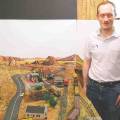 |
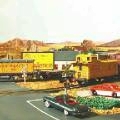 |
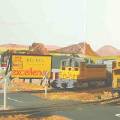 |
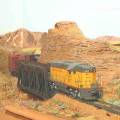 |
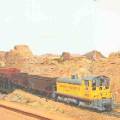 |
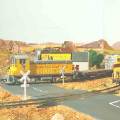 |